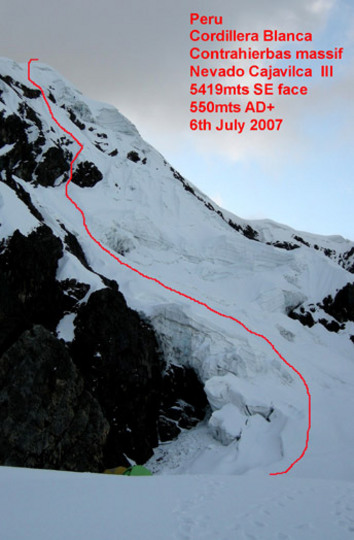
The southeast face of Cajavilca III (5419m) in the Contrahierbas Massif, Cordillera Blanca, Peru, showing the new route climbed by Tony Barton and John Pearson. This pair was probably the first to access the upper glacier basin below the east side of Contrahierbas. [Photo] Tony Barton
Although the mountains north and east of Huaraz must rank as some of the most frequented in South America, Peru’s Cordillera Blanca still holds many secrets. Tony Barton from the UK, on his sixth trip to Peru, recently climbed two new routes in rarely visited areas. With John Pearson, a current Huaraz resident, he traveled to the jungle side of the range and from there approached the Contrahierbas Massif from the northeast. Following a trail to the Mina Cajavilca, the pair was able to access the high glacier that sits east of Contrahierbas (6036m), one of the least-climbed 6000-meter peaks in the Blanca. There is only one route onto the upper glacier, and the pair believes they are the first party ever to reach it. From there the two made the first ascent of the southeast face of Cajavilca III (5419m), a 550-meter snow and ice face at AD+. From a camp on the glacier the route proved straightforward at first, giving 40 to 45-degree slopes to the first rock band. A short, steep step gave access to a gully and two pitches of 55-60 degrees led to a belay at the start of an ice ridge. Three more pitches of 50 to 55-degree snow led to the second rock band, which was circumvented on the right by a gully: the first pitch (initially 50 degrees) steepened to 70 degrees, and the second continued more or less to the summit at 55-60 degrees.
The Cajavilcas have only ever been ascended from the north, and it is not known how many times (if any) the three peaks that make up the group have been climbed since their first ascents back in 1966. In that year legendary Blanca explorer, John Ricker, visited the upper Ulta valley to the west of Contrahierbas. With Lisle Irwin he crossed the pass at the northern head of the valley and then descended northeast into the Ichia Ulta valley, from where he ascended southeast to a camp on the glacier below the Cajavilca group, three summits on the ridge falling northeast from the summit of Contrahierbas. The pair first climbed the easy northern slopes of Cajavilca III, from where they hoped to traverse the ridge to the higher summit. This failed, so they descended and five days later climbed the northwest ridge of Cajavilca II (5675m), then continued up the north ridge of Cajavilca I, which they followed to its 5775-meter summit.
Barton returned to the range a little later in the season with Xabier Arbulo for a crack at the unclimbed east face of Contrahierbas. This peak was first climbed in 1939 from the north by Germans Siegfried Rohrer, Karl Schimid and Hans Schweizer, who gained the upper northeast ridge and followed its corniced crest to the summit. In 1958 a group that included famous names in the history of American climbing, Fred Ayres, Henry Kendall, Graham Matthews, David Michael, Irene and Leigh Ortenburger, and George Whitmore climbed the northwest face from the upper Ulta valley for the second ascent. In 1971 Robert Schneider (US) and Geoff Wayatt (NZ) from a mostly New Zealand expedition climbed up to the middle section of the southwest ridge from the Ulta Valley, dropped down the far side for ca. 150 meters to reach the glacier and then climbed the left side of the south-southeast face above to the summit for only the fourth overall ascent of the mountain. There does not appear to have been any serious attempt on the east side before this year.
Arbulo and Barton chose to climb at night to avoid objective dangers and had reached ca. 5650m, above the major difficulties, when Arbulo was hit by a rock and dropped his rucksack. Half an hour previously the sun had hit the face, causing a certain amount of mayhem, and it was fortunate that the sky soon clouded over and allowed the pair to make a safe retreat. To that point the route had proved quite serious, traversing above a vertical 400-meter rock wall. Because of the difficulty in making a direct descent of the face, and the potential stonefall in daylight hours, the pair had taken full kit with them, intending to traverse the summit and descend to the west.
In late August, Barton and Jim Sykes walked into the Huaytapallana Valley on the southwest slopes of the Huandoy Group. Here they climbed the highest summit in a small cluster of rocky peaks known as Cerro Huaytapallana. The pair climbed the 300-meter northwest face to the 5000-meter top at about 5.8. This appeared to be the easiest line on the mountain, and the pair found no evidence of any previous ascent to the summit.